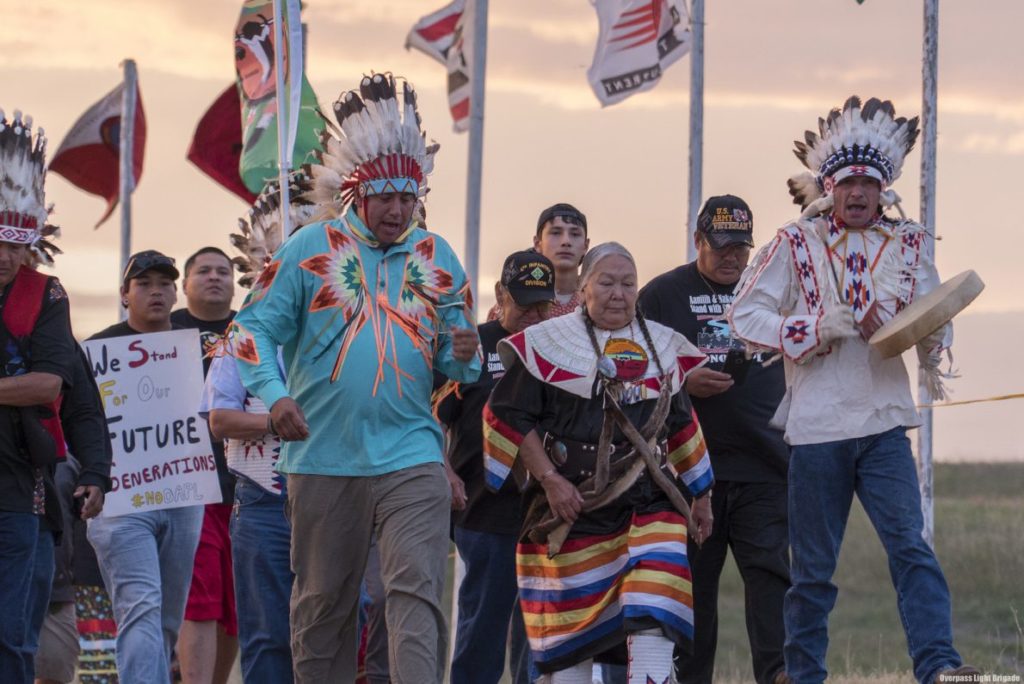How is it that in the Presidential debates this fall, the candidates were only asked one question about climate change? 2016 will be the hottest year ever recorded, extreme weather has caused severe flooding throughout the South and Southeast of the country, and scientists’ projections are becoming increasingly terrifying, yet the issue is not being discussed in the highest profile public forum in our democratic system.
Luckily for us, social movements are not leaving democracy to the politicians. They are taking action to defend our land and water and stop the energy model that is cooking the planet. In fact, history might look back and see that the most significant political event of 2016 was not the election but the fight at Standing Rock against the 1,172-mile Dakota Access Pipeline carrying fracked oil through indigenous peoples’ ancestral lands and across the biggest rivers in the country.
Since August, members of the Standing Rock Sioux Tribe have blocked the construction of the Dakota Access Pipeline (DAPL). They have set up camps on the land, refusing to let the construction continue.
The Pipeline is crossing the ancestral lands and waters of the Standing Rock Sioux, but according to the United Nations Special Rapporteur on the Rights of Indigenous Peoples, the company building the pipeline, Dakota Access, did not consult with the Tribe, in “violation of treaty rights, the United Nations Declaration on the Rights of Indigenous Peoples, and other international legal standards that require the free, prior, and informed consent of Indigenous Peoples.”
Tom Goldtooth, Director of the Indigenous Environmental Network, said, “What the US calls consultation is not consultation but a statement telling people what they’re doing after millions of dollars have been invested, painting Indigenous Peoples as spoilers. The right of free, prior and informed consent begins prior to the planning process, not when their bulldozers are at your doorstep.”
But the Standing Rock Sioux Tribe are not just fighting for their own land and water. They are fighting to protect everyone’s land and water, including those of us seven generations into the future.
The Dakota Access Pipeline is part of a longer fracked oil pipeline stretching from North Dakota to Illinois across and near many rivers and streams, including the Mississippi and Missouri. When an oil spill happens – and oil spills always happen with pipelines – it will poison the land and water of at least ten million people.
In their fight as “water protectors” and “land defenders,” the Standing Rock Sioux have inspired millions, and hundreds of tribes and thousands of Native Americans and allies have both traveled to North Dakota and taken action in their own communities.
Indigenous communities have always been the leaders of the climate justice movement, so it is no surprise that they are leading the fight here and now. Indigenous communities honor and respect the Rights of Mother Earth, yet they have been on the frontlines of ecological destruction for hundreds of years.
The Dakota Access Pipeline, on the other hand, is a land and water grab that represents the energy model destroying the planet. It is part of the long, 500-year history of land grabbing and natural resource grabbing of indigenous people in the United States and throughout the Western Hemisphere.
But the conflict between the protectors of the earth and the destroyers of the planet is heating up. Hundreds of millions of acres have been grabbed for mega energy and agribusiness projects in the past 10 years that predominantly displace indigenous people and peasants. These projects are for so-called “renewable” energy projects, but lands are flooded for massive dams and forests and small-scale farmland are cleared for industrial biofuels plantations.
The Climate Justice Alliance calls it the “dig, dump, and burn” model, and even in the search for “renewable” energy, it only sees ecosystems as sources for burning and extraction and not as sources of life that need to be protected.
This month, ActionAid USA is participating in the global campaign Reclaim Power, calling on governments to stop funding dirty energy that benefits the elites and ignores the people. To stop climate change, we need to stop using fossil fuels, and we need to stop “false solutions” like biofuels. But we also need to transform the extractive energy model that hurts the planet and ignores the people.
That is why the struggle against the Dakota Access Pipeline is so important: we will not stop climate change unless we recognize that communities have a fundamental right to decide how energy is produced.
Water is Life. No Dakota Access Pipeline.
To find out more, visit https://www.ienearth.org/stand-with-standing-rock-no-dapl.

